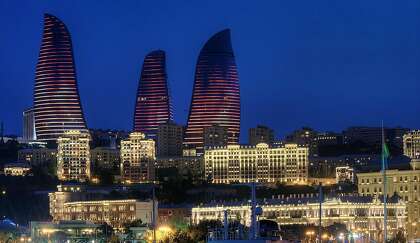Forget the harsh edge of the streets below or the grind of President Trump’s daily dramas. Cast your eyes upward instead, to San Francisco’s skyline with its soothing glow of seasonal colors.
Holiday lighting adorns the Ferry Building, the most venerable of landmarks, and Mission Street towers that in architectural terms are still wet behind the ears. Embarcadero Center’s towers are outlined precisely. City Hall’s regal dome and granite bays are bathed in hues of red and green.
Flourishes like these are signs of what I call the illuminated metropolis — yet another global trend leaving its mark on our city. As trends go, this one is benign and often pleasurable. But it also can have the feel of a gimmick that’s more interested in hashtag-friendly branding than the structures that are adorned.
Another sign of the times? Technological advances that rewrite cultural expectations.
“The number of (lighting) possibilities are much greater today” because of improvements in LED technology and operating systems, said Francis Krahe, a lighting specialist based in Los Angeles. “The components and the control systems have become much more efficient and much less expensive.”
Krahe’s firm has three offices, including one in China, and among its projects are the fantastical use of three flame-shaped towers in Azerbaijan as the screens for constantly shifting video displays. His most recent San Francisco project is more subdued: an elongated loop of lights that trace the diagonal oval summit of 399 Fremont, a 40-story apartment tower on Rincon Hill.

The strand can be programmed in 16,000 distinct color combinations, according to Krahe. Last week, no surprise, the view was a gentle blur of green to red and back again.
“It’s meant to be subtle, a pinstripe signature on the skyline, rather than a giant lantern,” he said. “Building illumination in San Francisco tends to be quite conservative, and very tasteful.”
Words like these are subjective, of course.
With the exception of the illuminated crown of Salesforce Tower — a public art installation conceived and still being refined by local artist Jim Campbell — San Francisco’s most obvious example of the trend is Bay Lights. Look toward the water from the Embarcadero and there it is, a nightly shimmer of computerized patterns from 11,000 LEDs attached to the thin, vertical cables of the west span of the Bay Bridge.
Bay Lights were installed in 2014 and made permanent in 2016, and to me it’s still no better than visual Muzak. But other people are fans, Krahe included — “They add a degree of charm and elegance.”
By contrast, it’s hard to imagine even the most churlish Scrooge objecting to City Hall’s long-running light show.
That Civic Center landmark is made radiant at night by 220 exterior fixtures that since 2016 have held LED bulbs. The physical lights don’t change, but their beams of color do, easily programmed from a computer in the basement of City Hall.
Not all of our seasonal displays are state of the art; the Ferry Building’s current frosting of red and green topped by blue (surprise!) was installed in one afternoon by three workers applying wraps of theatrical gel to 74 exterior lights added during the icon’s restoration in the early 2000s. The precise white outline of Embarcadero Center is a more formidable undertaking — workers spend six weeks every year stringing the cords along the outlines of four towers, then attaching 17,000 LED lights one by one.
This is the 33rd year that the multiblock office complex gets lit for the holidays. The less efficient incandescent bulbs used until a decade or so ago are long gone. But there are no plans to dispel the center’s evocation of a white Christmas.
“It’s what works for the towers,” said Helen Han, marketing director for Embarcadero Center’s owner, Boston Properties. “A classic standard, and a look we’ve always been know for.”
Smart call: The clean white lines are the ideal touch to emphasize the concrete folds of architect John Portman’s exercise in refined Brutalism, if such a thing exists. Similarly, the soft colored uplighting of City Hall and the Ferry Building accentuates the depth of those landmarks’ classical masonry.

Elsewhere, LED special effects lose their novelty all too fast.
That’s the case this month with 555 Mission, a 34-story glass tower from 2008 that conceals its rooftop mechanical outlets behind a tall lightbox. The holiday lighting sequence shifts bands of seasonal colors back and forth, sometimes slow and sometimes fast.
It’s as if there’s a yule-themed disco in the penthouse. Tantalizing at first. Then the thrill wears off.
Some people would say the same of Salesforce Tower’s rounded peak, with its pixelated imagery that sometimes resembles a slow-motion lava lamp. I give it leeway as a work in process, a canvas for such surprises as the recent four-night show of video art by 10 students from California College of the Arts.
Though things here are flashier now than a decade ago, San Francisco is a pale shadow of the color-saturated scenes in cities like Hong Kong and even London.
Cost is an issue; a fairly simple rooftop accent can require an outlay of $100,000 or more. So are environmental concerns, such as a local desire to keep artificial night lighting from washing out the view of stars above.
Which means that, realistically, our skyline won’t drown in lurid waves of attention-getting LED displays. And that’s fine — even to professionals who might benefit if they did.
“Not every building deserves to be lit — keep that in mind,” Krahe said. “Some towers are best left in the background.”
John King is The San Francisco Chronicle’s urban design critic. Email: jking@sfchronicle.com Twitter: @johnkingsfchron
"thing" - Google News
December 27, 2019 at 07:24AM
https://ift.tt/2snDmKb
San Francisco’s skyline has a holiday glow. It’s a global thing - San Francisco Chronicle
"thing" - Google News
https://ift.tt/2JDx9PK
Shoes Man Tutorial
Pos News Update
Meme Update
Korean Entertainment News
Japan News Update
No comments:
Post a Comment